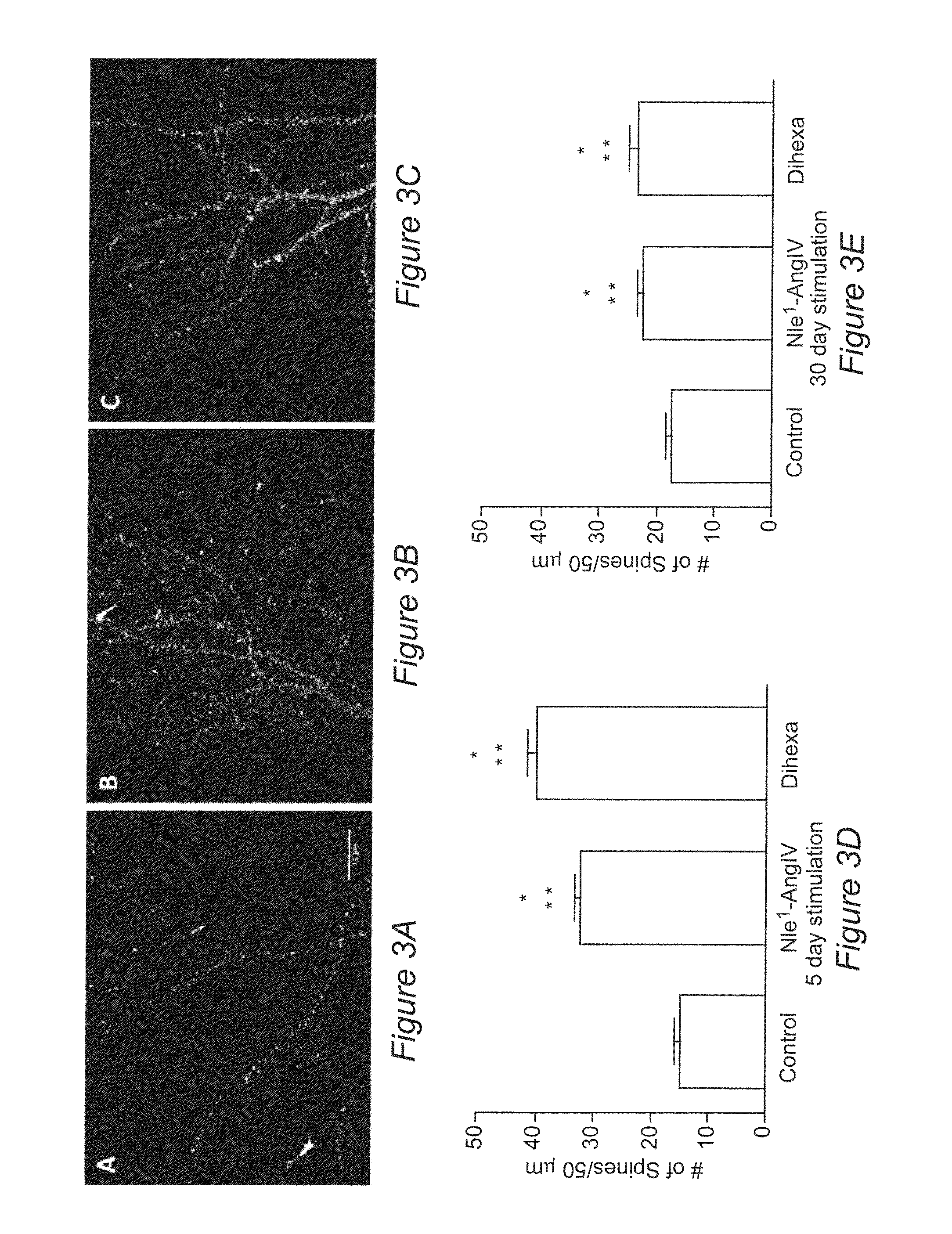Hepatocyte growth factor (HGF) mimics as therapeutic agents
- Summary
- Abstract
- Description
- Claims
- Application Information
AI Technical Summary
Benefits of technology
Problems solved by technology
Method used
Image
Examples
example 1
Regulation of Synaptogenesis by Dihexa and Nle1-AngIV
[0127]The tetrapeptide (Nle1-YIN) and tripeptide (Nle1-YI) fragments of the Nle1-AngIV analog of AngIV were previously found to be the smallest active fragments capable of overcoming scopolamine-induced cognitive dysfunction in a spatial learning task. Using the tripeptide as a new template, additional active analogues were synthesized with improved metabolic stability, blood brain barrier permeability, and oral activity. In this Example, we show the characterization of the novel, orally active, angiotensin IV analogue Dihexa.
Materials and Methods
Animals and Surgery.
[0128]Male Sprague-Dawley rats (Taconic derived) weighing 390-450 g were maintained with free access to water and food (Harland Tekland F6 rodent diet, Madison, Wis.) except the night prior to surgery when food was removed. Each animal was anesthetized with Ketamine hydrochloride plus Xylazine (100 and 2 mg / kg im. respectively; Phoenix Scientific; St. Joseph, Mo., and ...
example 2
The Target of AngIV Analogs is Hepatocyte Growth Factor
[0151]This Example shows that the novel angiotensin IV ligand Dihexa and its parent molecule Nle1-AngIV act through the HGF / c-Met receptor system.
Materials and Methods
Animals and Surgery
[0152]Male Sprague-Dawley rats (Taconic derived) weighing 390-450 g were maintained with free access to water and food (Harland Tekland F6 rodent diet, Madison, Wis.) except the night prior to surgery when food was removed. Each animal was anesthetized with Ketamine hydrochloride plus Xylazine (100 and 2 mg / kg im. respectively; Phoenix Scientific; St. Joseph, Mo., and Moby; Shawnee, Kans.). An intracerebroventricular (icy) guide cannula (PE-60, Clay Adams; Parsippany, N.Y.) was stereotaxically positioned (Model 900, David Kopf Instruments; Tujunga, Calif.) in the right hemisphere using flat skull coordinates 1.0 mm posterior and 1.5 mm lateral to bregma (Wright et al., 1985). The guide cannula measured 2.5 cm in overall length and was prepared wi...
example 3
Development of Antiotensin IV Analogs as Hepatocyte Growth
Factor / Met Modifiers
[0186]The 6-AH family [D-Nle-X-Ile-NH—(CH2)5—CONH2; where X=various amino acids] of Angiotensin IV analogs, bind directly to Hepatocyte Growth Factor (HGF) and inhibit HGF's ability to form functional dimers. The metabolically stabilized 6-AH family member, D-Nle-Tyr-Ile-NH—(CH2)5—CONH2, had a t1 / 2 in blood of 80 min compared to the parent compound Norleual (Nle-Tyr-Leu-Ψ-(CH2—NH2)3-4-His-Pro-Phe, SEQ ID NO: 1), which had a t1 / 2 in blood of 3H-hinge region peptide resulting in an attenuated capacity of HGF to activate its receptor Met. This interference translated into inhibition of HGF-dependent signaling, proliferation, and scattering in multiple cell types at concentrations down into the low picomolar range. We also noted a significant correlation between the ability of the 6-AH family members to block HGF dimerization and inhibition of the cellular activity. Further, a member of the 6-AH family with cy...
PUM
| Property | Measurement | Unit |
|---|---|---|
| Time | aaaaa | aaaaa |
| Therapeutic | aaaaa | aaaaa |
Abstract
Description
Claims
Application Information
 Login to View More
Login to View More - R&D
- Intellectual Property
- Life Sciences
- Materials
- Tech Scout
- Unparalleled Data Quality
- Higher Quality Content
- 60% Fewer Hallucinations
Browse by: Latest US Patents, China's latest patents, Technical Efficacy Thesaurus, Application Domain, Technology Topic, Popular Technical Reports.
© 2025 PatSnap. All rights reserved.Legal|Privacy policy|Modern Slavery Act Transparency Statement|Sitemap|About US| Contact US: help@patsnap.com



